US adds nickel and zinc to the critical minerals list
RESTON, Va. – The U.S. Geological Survey has announced it is seeking public comment by December 9, on a draft revised list of critical minerals to all sectors of economy including tech and defense.
“The USGS’s critical minerals list provides vital information for industry, policymakers, economists and scientists on the most important minerals when it comes to U.S. supply chains,” said Tanya Trujillo, Assistant Secretary of the Interior for Water and Science. “The statistics and information are crucial to understanding America’s vulnerability to disruptions in the supply of critical minerals, including data on the worldwide supply and demand for minerals and materials essential to the U.S. economy and national security.”
Under the Energy Act of 2020, a “critical mineral” is defined as a non-fuel mineral or mineral material essential to the economic or national security of the U.S., as well as the supply chain, which is vulnerable to disruption. Critical minerals are also characterized as serving an essential function in the manufacturing of a product, the absence of which would have significant consequences for the economic or national security.
Under the Energy Act of 2020, at least every three years the Department is required to review and update the list of critical minerals, update the methodology used to identify potential critical minerals, take interagency feedback and public comment through the Federal Register, and ultimately finalize the list of critical minerals, also referred to as the whole-of-government critical minerals list.
After two years, working with the National Science and Technology Council’s Critical Minerals Subcommittee, the USGS published a report describing the updated methodology for assessing critical minerals for the list and latest results. This report formed the basis for the draft 2021 whole-of-government critical minerals list.
The draft 2021 whole-of-government critical minerals list includes the following — click a mineral’s name to find relevant statistics and publications:
- Aluminum, used in almost all sectors of the economy
- Antimony, used in lead-acid batteries and flame retardants
- Arsenic, used in semi-conductors
- Barite, used in hydrocarbon production.
- Beryllium, used as an alloying agent in aerospace and defense industries
- Bismuth, used in medical and atomic research
- Cerium, used in catalytic converters, ceramics, glass, metallurgy, and polishing compounds
- Cesium, used in research and development
- Chromium, used primarily in stainless steel and other alloys
- Cobalt, used in rechargeable batteries and superalloys
- Dysprosium, used in permanent magnets, data storage devices, and lasers
- Erbium, used in fiber optics, optical amplifiers, lasers, and glass colorants
- Europium, used in phosphors and nuclear control rods
- Fluorspar, used in the manufacture of aluminum, cement, steel, gasoline, and fluorine chemicals
- Gadolinium, used in medical imaging, permanent magnets, and steelmaking
- Gallium, used for integrated circuits and optical devices like LEDs
- Germanium, used for fiber optics and night vision applications
- Graphite , used for lubricants, batteries, and fuel cells
- Hafnium, used for nuclear control rods, alloys, and high-temperature ceramics
- Holmium, used in permanent magnets, nuclear control rods, and lasers
- Indium, used in liquid crystal display screens
- Iridium, used as coating of anodes for electrochemical processes and as a chemical catalyst
- Lanthanum, used to produce catalysts, ceramics, glass, polishing compounds, metallurgy, and batteries
- Lithium, used for rechargeable batteries
- Lutetium, used in scintillators for medical imaging, electronics, and some cancer therapies
- Magnesium, used as an alloy and for reducing metals
- Manganese, used in steelmaking and batteries
- Neodymium, used in permanent magnets, rubber catalysts, and in medical and industrial lasers
- Nickel, used to make stainless steel, superalloys, and rechargeable batteries
- Niobium, used mostly in steel and superalloys
- Palladium, used in catalytic converters and as a catalyst agent
- Platinum, used in catalytic converters
- Praseodymium, used in permanent magnets, batteries, aerospace alloys, ceramics, and colorants
- Rhodium, used in catalytic converters, electrical components, and as a catalyst
- Rubidium, used for research and development in electronics
- Ruthenium, used as catalysts, as well as electrical contacts and chip resistors in computers
- Samarium, used in permanent magnets, as an absorber in nuclear reactors, and in cancer treatments
- Scandium, used for alloys, ceramics, and fuel cells
- Tantalum, used in electronic components, mostly capacitors and in superalloys
- Tellurium, used in solar cells, thermoelectric devices, and as alloying additive
- Terbium, used in permanent magnets, fiber optics, lasers, and solid-state devices
- Thulium, used in various metal alloys and in lasers
- Tin, used as protective coatings and alloys for steel
- Titanium, used as a white pigment or metal alloys
- Tungsten, primarily used to make wear-resistant metals
- Vanadium, primarily used as alloying agent for iron and steel
- Ytterbium, used for catalysts, scintillometers, lasers, and metallurgy
- Yttrium, used for ceramic, catalysts, lasers, metallurgy, and phosphors
- Zinc, primarily used in metallurgy to produce galvanized steel
- Zirconium, used in the high-temperature ceramics and corrosion-resistant alloys.




